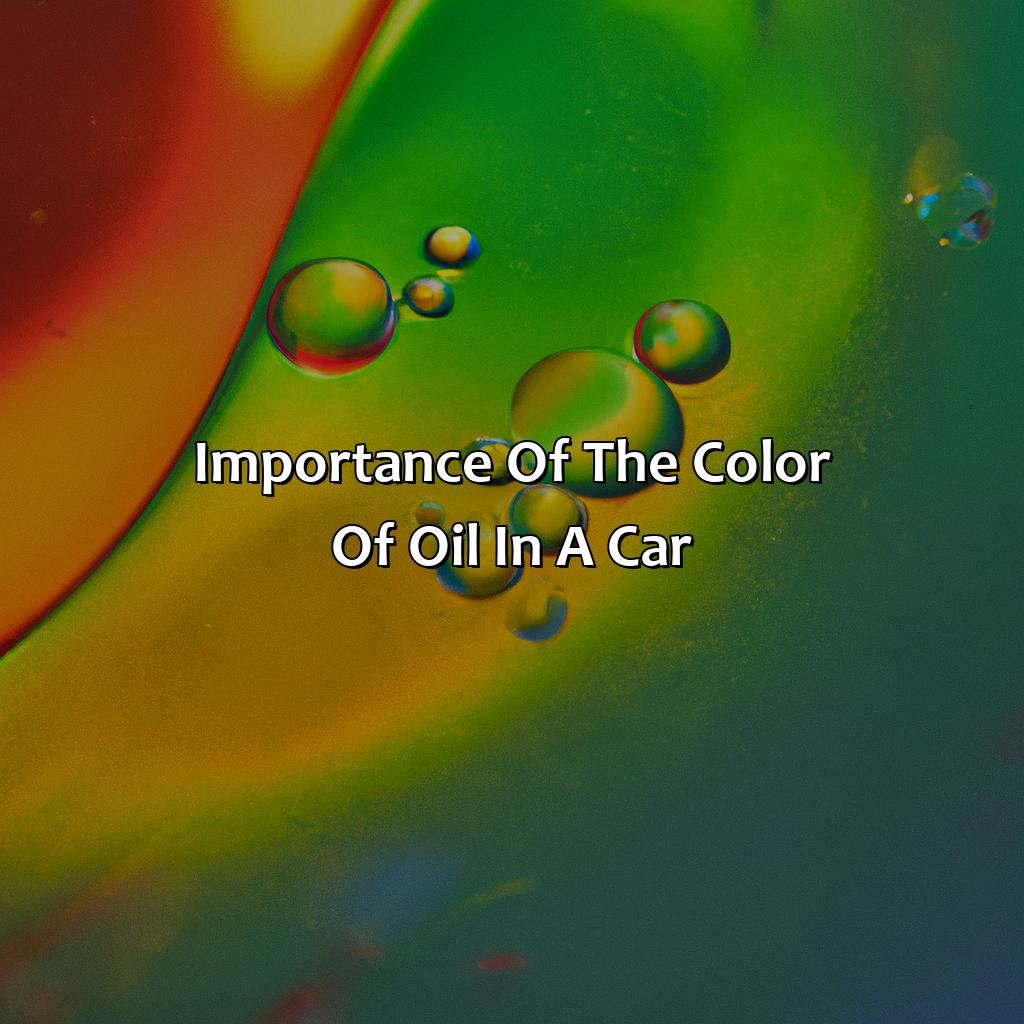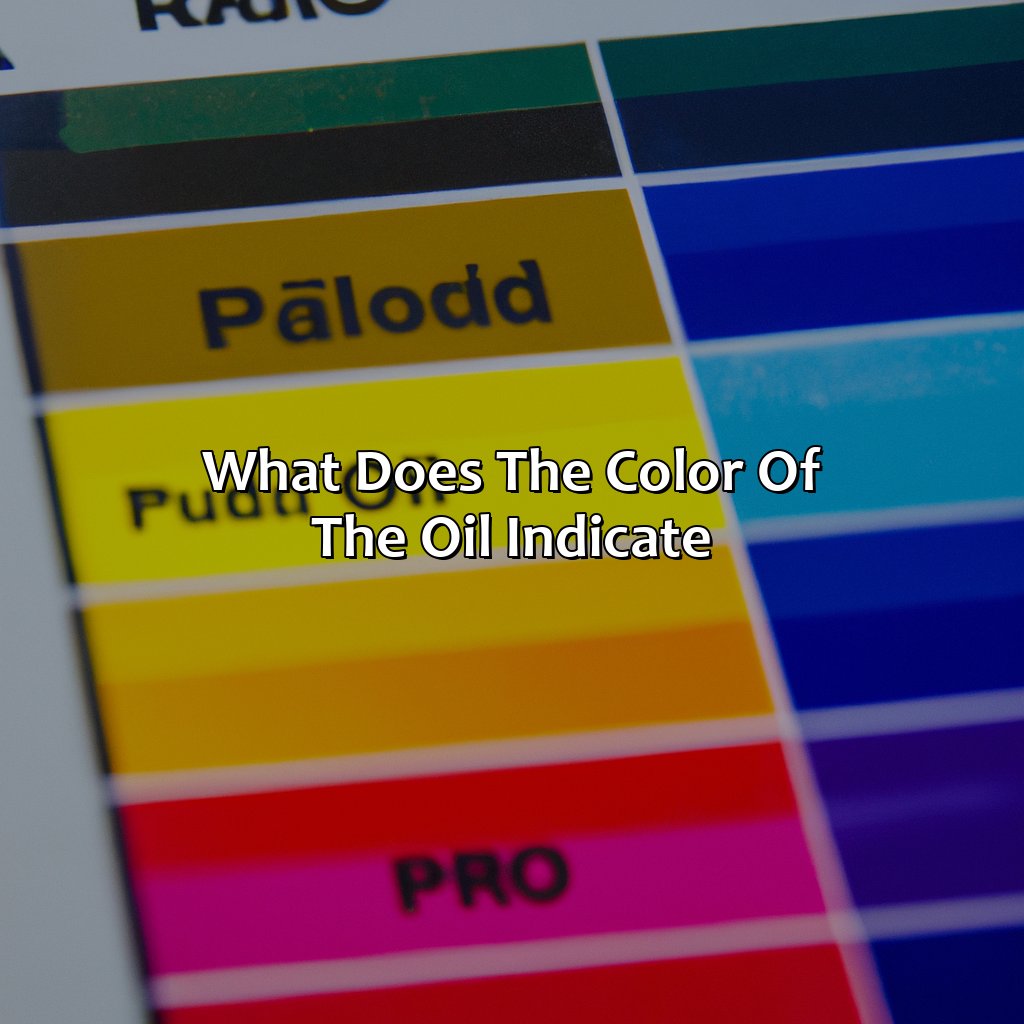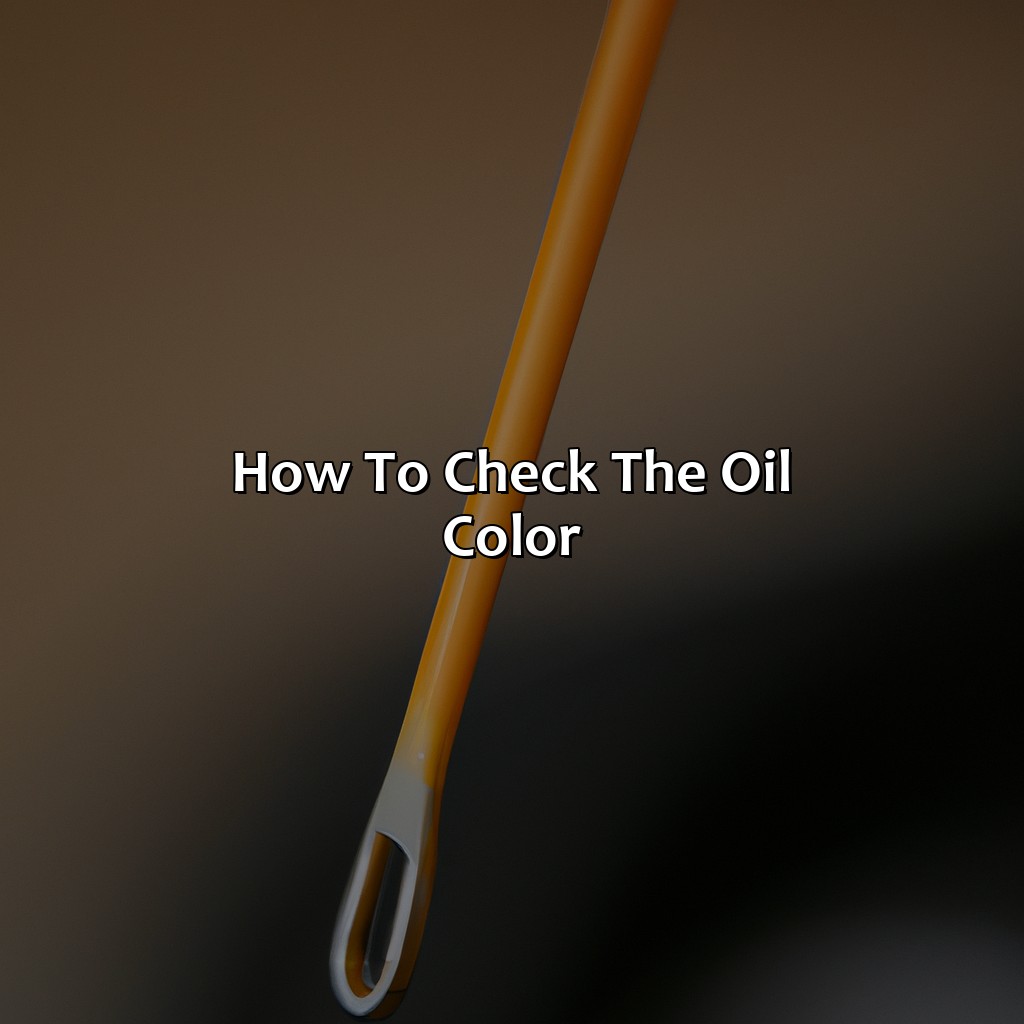Key Takeaway:
- Car oil color is an important indicator of the health of an engine: The color of your car oil can indicate whether it is healthy or not. A clear and transparent oil color indicates fresh and healthy engine oil, while darker and cloudy or milky oil color can indicate contamination.
- The color of car oil indicates the presence of contaminants and the condition of the engine: A yellow/brown oil color indicates healthy engine oil, while dark/black oil color can indicate poor maintenance and contamination. Milky/foamy oil color can indicate moisture, coolant or other contaminants in the engine oil.
- Based on the color of car oil, it is important to take appropriate action: If the oil color is yellow/brown, it is an indication of healthy engine oil. If it is dark/black, an oil change may be needed along with an inspection of the engine. If the oil color is milky/foamy, it may indicate a coolant or other contaminant issue, and a mechanic should be consulted.
Importance of the color of oil in a car

Photo Credits: colorscombo.com by Kyle Flores
The color of car oil is of great importance and can provide crucial information about the health of the engine. Different oil colors can indicate varying levels of contamination and degradation. Mechanics often use the color of the oil to determine the frequency of oil changes and the overall maintenance of the vehicle.
A clean, amber-colored oil indicates good engine health, while a dark, burnt color signifies the need for an oil change. The color of engine oil can also be affected by additives, such as detergents and dispersants, which aid in cleaning the engine. It is always recommended to check the car oil color regularly for optimal engine performance.
Moreover, the color of engine oil can be influenced by the type or brand of motor oil used. Some premium oils have a natural green or blue color, which can further confuse the color identification process. Therefore, it is important to check the owner’s manual for the recommended type of oil and consult with a professional mechanic for any color concerns.
Motor oil color is also affected by the environment and driving conditions, such as high temperatures or stop-and-go traffic. A regular oil change routine and proper maintenance can prolong the life of the engine and improve its overall performance.
Car oil color can vary greatly according to the make and model of the vehicle, as well as the type of oil used. It is recommended to always check the oil color before driving the car to avoid any potentially expensive repairs. According to a study by Consumer Reports, a dark brown or black oil color can reduce the engine’s efficiency by 3-5%, resulting in higher fuel consumption and emission levels. Therefore, monitoring the car oil color is a simple yet effective way to ensure the longevity and efficiency of the engine.
What does the color of the oil indicate?

Photo Credits: colorscombo.com by Russell Carter
What does the color of oil indicate? Refer to an oil color chart or guide. Check the shade of the oil on the dipstick. This helps determine its meaning.
Let’s look at yellow/brown, dark/black, and milky/foamy oil colors. Each color can signal a different issue. So, be aware of what oil color light brown, oil color gold, oil color dark, oil color black, oil color brown, oil color purple, or any other shade could mean for your vehicle.
Yellow/brown oil
The hue of oil on dipstick conveying crucial information to car owners. The light brown or golden color of the oil ensures that oil is clean, fresh, and suitable for the vehicle. Cars need fresh oil with an adequate viscosity to lubricate engine components efficiently.
In addition, a yellow/brown color represents the ideal oil condition. This clear and translucent appearance indicates that there are no impurities present in the system. The presence of dirt may affect engine performance while dilution with water can result in slow engine start-up.
Car owners should keep an eye out for any potential changes in the color of their car’s oil since examining the oil’s hue at every 7,500-mile interval of driving is critical to identifying and addressing any concerns.
Therefore, it is important to ensure that light brown or golden hued oils remain in vehicles for maximum efficiency and performance. Negligence in maintaining proper oil quality can lead to costly repairs or even total malfunctioning of vehicles over time. Stay informed about your vehicle’s requirements by monitoring your car’s oil regularly! You don’t want your engine running on oil that looks like it’s auditioning for a role in a horror movie.
Dark/black oil
The color of oil in a car is indicative of the condition and age of the engine oil. Dark or black colored oil indicates that the oil has been in use for an extended period and has accumulated debris and dirt particles. This can lead to reduced efficiency and performance of the engine.
Furthermore, if the oil color darkens over a short period, it may indicate problems with the engine’s gaskets or seals, causing oil leaks into areas where it should not be. These leaks can create a safety hazard if they occur in areas such as near the exhaust system or on other hot parts, which can lead to serious consequences.
It is important to keep in mind that modern engines often use oils with additives designed to change their colors from yellow to brown early in their life cycles. On occasion, purple colored oil indicates contaminated or poor quality fuel effects on vehicle output.
A high-quality synthetic may darken after only 3k miles or 5k kilometers while another brand might go up to 10K miles without significant color change because of brand difference.
Pro Tip: Consult your owner’s manual for guidance on how frequently to test your car’s oil based on its make and model. Checking your car’s gear regularly can improve its performance and longevity significantly.
Looks like your car has a cappuccino machine instead of an engine with that milky oil color.
Milky/foamy oil
Oil that appears to be cloudy and has a foamy texture is an indication of a serious problem with the engine. This type of oil is caused by the presence of water or antifreeze in the oil. The milky appearance of the oil indicates contamination and needs to be addressed immediately.
Continuing to run the car with this type of oil can cause permanent damage to the engine. It is important to identify what caused the contamination, as it could be due to a blown oil cooler, blown head gasket, or cracked engine block.
Regularly checking the oil color and consistency is crucial in maintaining vehicle health. If there are doubts about the quality of the oil being used, it might be worthwhile to switch to a higher-grade option for optimum performance. Comparing different grades and colors of oils will help determine which one works effectively for specific vehicles.
Given its rarity, sometimes even experienced drivers may make mistakes in changing the oil on time. If left unchanged for too long, sludge buildup from dirty oil will lead to contamination and cause later issues like increased fuel consumption, poor driving response or stalling while doing long drives.
To avoid potential damage like this creeping up on you out of nowhere, it’s imperative you stay vigilant in keeping up with when your car needs changing its motor oil—so don’t wait any longer!
Your car’s oil color may indicate a problem, but if it’s rainbow-colored, it’s probably just magical.
What should be done based on the color of the oil?

Photo Credits: colorscombo.com by William Martinez
Examining the color of your car’s engine oil can show its condition. If it is discolored, something could be wrong. Check the color when it’s hot or cold, depending on the oil type.
This section has 3 sub-sections:
- Yellow/brown: This sub-section points out oil variation with yellow/brown color. Car owners should check for oil quality issues such as oxidation, inadequate oil changes, and poor driving habits.
- Dark/black: This sub-section points out oil variation with dark/black color. Car owners should watch for oil quality issues such as engine overheating, too much contaminants, and poor driving habits.
- Milky/foamy: This sub-section points out oil variation with milky/foamy appearance. Car owners should watch for oil quality issues such as coolant mixing with oil, head gasket failure, and transmission oil mixing with engine oil.
Each sub-section shows the oil quality issues car owners should watch for.
Yellow/brown oil
The vital importance of oil color in a car lies in the indication of the engine’s condition. Yellow/brown oil indicates that oil is fresh and has yet to be contaminated with impurities. It is indicative of proper functioning of the engine lubrication system. However, it can turn darker over time and requires frequent checks.
Continual operation may turn 5w20 oil color into dark/black, which suggests carbon particle build-up and poor-quality oil. This leads to problems like clogging and increased friction leading to engine damage. Consider changing 5w30 or other types’ colour if it appears black.
Using an oil viscosity color chart, a change in the appearance of the 5w20 or any other variant is noticeable; milky-white/frothy colored could indicate water, coolant or fuel leakages and may need repair.
It is essential to adhere to normal car maintenance guidelines by checking fluid levels frequently, including monitoring provided intervals for checking oils according to manufacturers’ recommendations, keeping them clean and fresh.
A friend shared his experience when their car repeatedly faced brake-related issues despite proper maintenance. Upon inspection at a mechanic’s workstation confirmed their suspicion- dark motor oil level which was overlooked in regular checks damaged crucial components resulting brake-failure incidents.
Black oil means it’s time to invite your car to a spa day and give him a fresh coat of synthetic oil.
Dark/black oil
The appearance and color of oil are excellent indicators of its condition and health. When the oil becomes dark or black, it signals that mold and other contaminants have developed in the fluid. The synthetic oil color does not necessarily turn darker over time, but diesel oil can quickly turn black due to various factors. Used oil color also tends to become increasingly darker.
A shift in the oil appearance and color occurs when the oil becomes dirty. The heat generated by the engine causes detergents in the oil to break down, causing particle buildup in the liquid. While there is not a concrete timeline on how often an engine’s oil should be changed, once the oil appears dark or black, it is time for a change.
Changing engine oils based on its usage pattern and mileage can increase both performance and longevity. The milky/foamy texture of motor oil signifies a significant problem that involves water contamination or potential oxidation problems with transmission fluids.
Diesel engines tend to generate soot particles during combustion which starts showing up as black particles mixed within the hydraulic fluid. Also, used oils tend to become laden with heavy metals like lead and form compounds closely associated with oxidation problems in today’s internal combustion engines.
In summary, changing engine oils based on visual inspection remains vital for ensuring vehicle performance optimization. A study of used oils can shed light on several aspects like soot generation rates during combustion while providing valuable insights about engine wear patterns; therefore prolonging vehicle life expectancy by avoiding unforeseen failures that could lead to catastrophic impacts.
Looks like your car’s oil has been hitting the cappuccinos instead of the engines.
Milky/foamy oil
Oil smoke color is usually attributed to a milky or foamy appearance which arises from the mixing of oil with other fluids like water or coolant. This occurrence often indicates a significant issue in the engine, such as a blown gasket that has allowed the mixing of fluids. Contaminated hydraulic oil color can cause damage to pumps, seals, and valves. Transmission oil color can reveal any leaks in the transmission system leading to overheating and reduced performance.
If milky/foamy oil is discovered upon inspection, it is essential to take immediate action as this indicates severe damage to the engine. A proper diagnosis must be conducted to identify any leaks or malfunctions responsible for causing the contamination and further driving should be avoided until repairs have been made.
Ignoring this issue can lead to catastrophic failure of critical engine components, resulting in extensive repair bills. Therefore, it is crucial to detect any issues early by checking oil regularly and replacing it according to manufacturer recommendations.
Changing your oil based on its color is like going to a doctor because your t-shirt is dirty.
When to change the oil?

Photo Credits: colorscombo.com by Billy Rodriguez
When is it necessary to change the oil in your car? It depends on several factors, including the type of oil and how often the vehicle is used. Regularly monitoring the oil drain color can help determine when it’s time for an oil change. If the oil appears darker or contains debris, it’s time to change the oil. Additionally, different oil types may have different recommended change intervals. It’s important to consult the owner’s manual for your specific vehicle to determine the appropriate schedule.
In addition to monitoring the oil drain color, other signs that it’s time for an oil change include strange noises from the engine, a decrease in fuel efficiency, or a noticeable decrease in engine performance. Neglecting to change the oil can lead to engine damage and costly repairs.
Changing the oil at the appropriate intervals can help extend the life of your engine and prevent damage. It’s important to use the recommended oil type and color for your vehicle, as using the wrong type of oil can also cause damage.
Regular maintenance, including oil changes, is essential for keeping your car in top condition. Don’t wait until it’s too late – make sure to follow the recommended oil change schedule for your vehicle.
How to check the oil color?

Photo Credits: colorscombo.com by Christian Lee
When checking the color of your car’s oil, it is important to do so properly to ensure that the oil is not contaminated. To check the oil color, locate the oil dipstick and remove it from the engine. Wipe the dipstick clean and reinsert it fully into the engine. Pull the dipstick out and examine the color of the oil on the end of the stick against a light-colored background. The oil should have a clear amber color. If the oil appears black or brown, it may be time for an oil change or further oil analysis.
Here is a Six-step guide to check the oil color:
- Locate the oil dipstick and remove it from the engine.
- Wipe the dipstick clean and reinsert it fully into the engine.
- Pull the dipstick out and examine the color of the oil on the end of the stick against a light-colored background.
- The oil should have a clear amber color.
- If the oil appears black or brown, it may be time for an oil change or further oil analysis.
- Record the results of the oil color test for future reference.
It is also important to note that oil color can indicate the oil viscosity level. A color analysis chart can be used to determine if the oil is in the correct viscosity range for the vehicle. Additionally, it is best to check the oil color when the engine is warm and has been turned off for at least 10 minutes. This allows the oil to settle and should provide an accurate reading. Finally, regularly checking the oil color and making any necessary changes can prolong the life of your vehicle’s engine.
Some Facts About What Color Should Oil Be In A Car:
- ✅ The color of engine oil should be amber or golden brown. (Source: Farmers Almanac)
- ✅ Black or dark brown oil is an indication that the oil needs to be changed. (Source: Bridgestone)
- ✅ If the oil appears milky or foamy, it could be an indication of a coolant leak. (Source: Advance Auto Parts)
- ✅ Green or yellow colored oil could indicate the presence of coolant in the oil. (Source: ThoughtCo)
- ✅ The type of oil used can also affect its color, with synthetic oils appearing lighter in color than conventional oils. (Source: Car Bibles)
FAQs about What Color Should Oil Be In A Car
What color should oil be in a car?
The color of oil in a car can vary, but generally, fresh oil will be a light amber color. Over time and with usage, the oil may darken. However, if the oil appears thick, sludgy, or has a milky color, this can indicate a problem and should be checked by a professional mechanic.
Why does the color of oil matter?
The color of oil can be an indicator of the oil’s age and effectiveness. Fresh oil is usually a clear, amber color. If the oil appears dark or thick, it could be a sign that it needs to be changed. Oils that appear to have a milky color may contain water and should be checked by a mechanic, as this can indicate a potential coolant leak or other serious issue.
What does it mean if my oil is a milky color?
If your car’s oil takes on a milky color, it is likely due to water contamination. This can be caused by a number of issues, such as a blown head gasket or a damaged cylinder head. It is important to have this issue addressed as quickly as possible by a professional mechanic, as continued driving can result in significant engine damage and potential safety hazards.
Why does oil turn dark over time?
Oil can turn dark over time due to exposure to oxygen, combustion byproducts, and dirt and debris that accumulate in the engine. As the oil is exposed to these elements, it becomes less effective in lubricating the engine, and can lead to increased wear and tear and potential engine damage. It is important to have the oil regularly changed according to the manufacturer’s recommendations to ensure optimal engine performance and longevity.
Is it normal for oil to change color between oil changes?
Yes, it is normal for oil to change color over time and between oil changes. As the oil is exposed to oxygen and the elements inside the engine, it can darken and become less effective. However, if the oil appears thick or sludgy, or has a milky color, this may indicate a problem and should be checked by a mechanic.
What should I do if my oil is discolored or has an unusual appearance?
If you notice that your car’s oil is discolored or has an unusual appearance, such as a milky color or thick consistency, it is important to have it checked by a professional mechanic as soon as possible. Continuing to drive with contaminated or degraded oil can lead to engine damage and potential safety hazards. It is always best to have the issue addressed quickly to ensure optimal engine performance and longevity.





